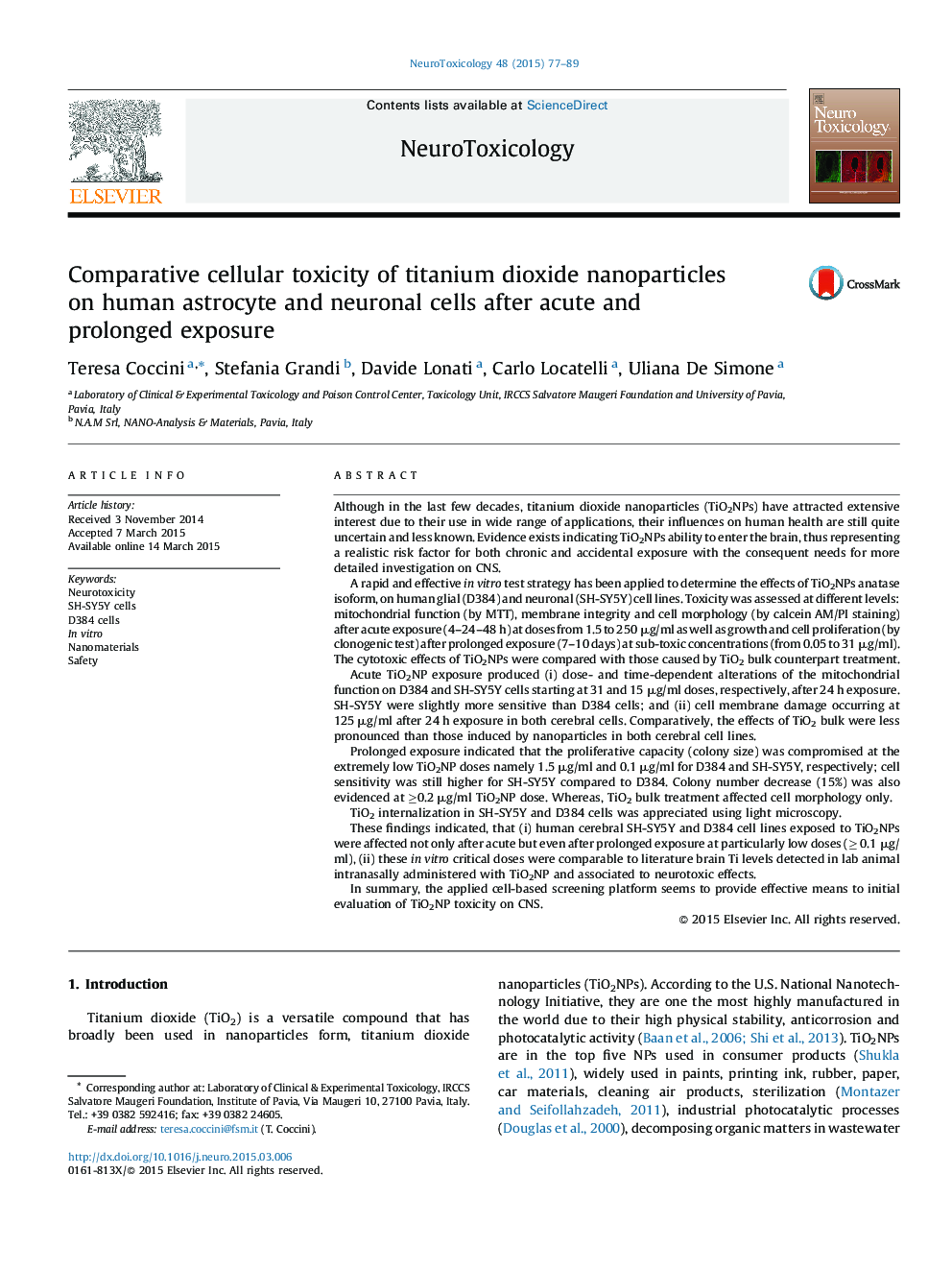| کد مقاله | کد نشریه | سال انتشار | مقاله انگلیسی | نسخه تمام متن |
|---|---|---|---|---|
| 2589521 | 1562046 | 2015 | 13 صفحه PDF | دانلود رایگان |
• Anatase TiO2NPs produced cytotoxicity in in vitro CNS cell lines.
• Effects were evident after acute and even after prolonged exposure to low doses.
• SH-SY5Y showed higher susceptibility than D384 cells.
• TiO2 bulk produced a smaller effect than TiO2NP or even no effect.
• The cell-based screening platform provided effective means to evaluate TiO2NP toxicity on CNS.
Although in the last few decades, titanium dioxide nanoparticles (TiO2NPs) have attracted extensive interest due to their use in wide range of applications, their influences on human health are still quite uncertain and less known. Evidence exists indicating TiO2NPs ability to enter the brain, thus representing a realistic risk factor for both chronic and accidental exposure with the consequent needs for more detailed investigation on CNS.A rapid and effective in vitro test strategy has been applied to determine the effects of TiO2NPs anatase isoform, on human glial (D384) and neuronal (SH-SY5Y) cell lines. Toxicity was assessed at different levels: mitochondrial function (by MTT), membrane integrity and cell morphology (by calcein AM/PI staining) after acute exposure (4–24–48 h) at doses from 1.5 to 250 μg/ml as well as growth and cell proliferation (by clonogenic test) after prolonged exposure (7–10 days) at sub-toxic concentrations (from 0.05 to 31 μg/ml). The cytotoxic effects of TiO2NPs were compared with those caused by TiO2 bulk counterpart treatment.Acute TiO2NP exposure produced (i) dose- and time-dependent alterations of the mitochondrial function on D384 and SH-SY5Y cells starting at 31 and 15 μg/ml doses, respectively, after 24 h exposure. SH-SY5Y were slightly more sensitive than D384 cells; and (ii) cell membrane damage occurring at 125 μg/ml after 24 h exposure in both cerebral cells. Comparatively, the effects of TiO2 bulk were less pronounced than those induced by nanoparticles in both cerebral cell lines.Prolonged exposure indicated that the proliferative capacity (colony size) was compromised at the extremely low TiO2NP doses namely 1.5 μg/ml and 0.1 μg/ml for D384 and SH-SY5Y, respectively; cell sensitivity was still higher for SH-SY5Y compared to D384. Colony number decrease (15%) was also evidenced at ≥0.2 μg/ml TiO2NP dose. Whereas, TiO2 bulk treatment affected cell morphology only.TiO2 internalization in SH-SY5Y and D384 cells was appreciated using light microscopy.These findings indicated, that (i) human cerebral SH-SY5Y and D384 cell lines exposed to TiO2NPs were affected not only after acute but even after prolonged exposure at particularly low doses (≥ 0.1 μg/ml), (ii) these in vitro critical doses were comparable to literature brain Ti levels detected in lab animal intranasally administered with TiO2NP and associated to neurotoxic effects.In summary, the applied cell-based screening platform seems to provide effective means to initial evaluation of TiO2NP toxicity on CNS.
Journal: NeuroToxicology - Volume 48, May 2015, Pages 77–89
